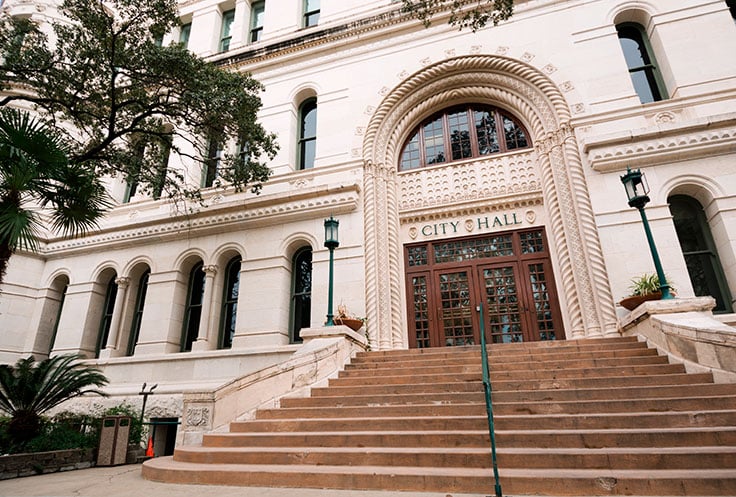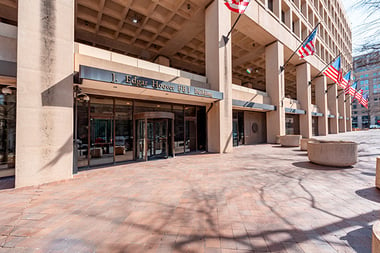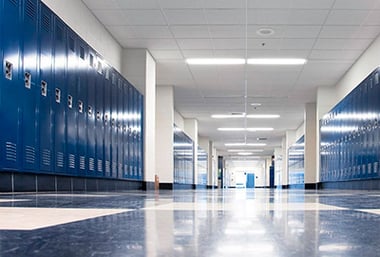From the federal legislature down to local municipalities, there has been a push at all levels of government to embrace energy efficiency and sustainable practices.
One example of this in action is the Federal Sustainability Plan, which sets a number of emissions reduction goals, including net-zero emissions in buildings by 2045. When you consider that the federal government alone owns and leases more than 376.9 million square feet of space, these goals represent a major commitment.
The U.S. Department of Energy has also taken action to support state governments as they work to meet energy-efficiency goals.
And governments of all shapes and sizes are continually looking for ways to reduce costs and help save taxpayer money.
But ... how will governments achieve these goals? One answer lies within LED lighting. LEDs are more energy efficient than incandescent bulbs and produce fewer carbon emissions. As the U.S. Department of Energy says, LEDs have “the potential to fundamentally change the future of lighting in the United States.”
With this much governmental support, and so much work to be done, there is a tremendous opportunity for you to sell LED lighting.
But if you’re looking to enter this market, it’s important you understand the unique nuances of working within this sector. That’s why we’ve created this guide to serve as your introduction to selling to government clients.
Get the E-book: LED Lighting for Government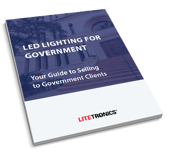
To jump to a specific section, click on one of the links below.
Understand the Different Kinds of Government Clients
If you’re interested in selling LED lighting to government clients, it helps to know which kinds of government clients you might run into, as well as some of the pros and cons of working with each. Here’s a high-level overview of the four most common types of government clients.
Federal Government
Federal government buildings are any that are owned or leased by the United States government. These might include courthouses, post offices, FBI field offices, national park offices and facilities, or any federally owned/operated facility.
Pros:
The federal government, through the U.S. General Services Administration, has been particularly proactive about green building design and retrofits. There is a big appetite for solutions like LED lighting that will help federal buildings meet energy-efficiency goals.
Cons:
The federal government tends to have more regulation than civilian clients. For example, the Buy American Act restricts some federal buildings to domestically produced materials. If you use LEDs produced overseas, you may not qualify for certain contracts.
This is only one example, but it will be important that you understand the regulatory environment up front before you get too far into the process.
Military Bases
You could argue that military bases should fall under the “federal government” category, but in practice they’re a very different animal. Military bases have their own needs and requirements, as well as regulations you may not be used to.
Pros:
Military bases offer a lot of opportunity. The sheer number and variety of buildings on a military base mean there’s a huge potential for LED lighting retrofits, including both indoor, exterior, and security lighting.
Cons:
You will likely have to jump through a lot of hoops to get access to a military base. There are also a number of confounding considerations when it comes to exterior lighting, which has to meet certain criteria so as not to interfere with military aircraft.
State and Local Governments
State and local governments don’t always come with as much red tape as their federal cousins, but they will also have much smaller budgets. Even so, many of these smaller government buildings and offices are in need of LED retrofits.
Pros:
While the federal government has set itself some ambitious sustainability goals, smaller governments tend to be motivated by saving money. LED lighting, which offers a great return on investment, can be very appealing to these types of clients.
Cons:
As with the other types of government clients we’ve discussed, even smaller governmental entities may have a lot of red tape and hoops that you’ll have to jump through.
Schools
When you think of government clients, your first thought might not be public schools. But with more than 130,000 K-12 schools and 52,000 higher education buildings, schools represent a huge opportunity when it comes to LED lighting — so much so that we created an entire guide to help you sell to these customers. Check it out!
Understand Why Government Clients Want LED Lighting
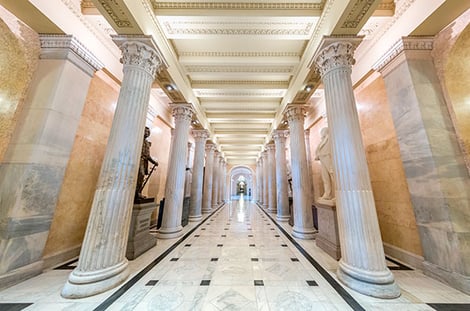 The bottom line with government clients is they want what you’re selling: LED lighting offers a simple solution for governing bodies concerned about climate change, energy efficiency, and reducing operational expenses. And in some situations, such as federal building construction, your government clients will be required to meet specific efficiency standards that will require LED lighting.
The bottom line with government clients is they want what you’re selling: LED lighting offers a simple solution for governing bodies concerned about climate change, energy efficiency, and reducing operational expenses. And in some situations, such as federal building construction, your government clients will be required to meet specific efficiency standards that will require LED lighting.
Security is another major concern for government clients, especially on military bases or around federal buildings. Reliable exterior lighting, such as Litetronics LED Garage Light fixtures, help to provide excellent visibility all year long. Coupling this with emergency battery backup is a great way to provide your government clients with real peace of mind about their lighting.
But what about smaller clients, such as state and local governments or school districts? While energy-efficiency and safety are important to these organizations, it’s also key to remember that they’re operating on some very slim margins.
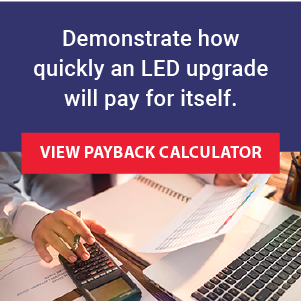 When selling to these clients, make sure that you emphasize the financial savings they’re likely to see. You can also use our payback calculator to help demonstrate to them how quickly an LED upgrade will pay for itself.
When selling to these clients, make sure that you emphasize the financial savings they’re likely to see. You can also use our payback calculator to help demonstrate to them how quickly an LED upgrade will pay for itself.
Finally, keep in mind that government institutions of all sizes like to try and lead by example. In addition to offering incentives and rebates to support energy efficiency, government clients want to find ways to demonstrate their commitment to reducing energy consumption. LED lighting projects are a great way to do it.
Understand Who You're Selling To
 Government clients sometimes have a bad reputation for putting their vendors through the wringer.
Government clients sometimes have a bad reputation for putting their vendors through the wringer.
And it is true that government projects tend to have more red tape and regulatory hoops to jump through, and the bid process can be lengthy and tough.
But none of this means you shouldn’t sell to these clients. There’s a tremendous amount of opportunity here. But it helps to understand how the process works and to know who you’re likely to work with.
The End User
The end user is typically the person who decided there was a need for a lighting project. Once they’ve reached this conclusion, they’ll pass the responsibility on to the procurement arm of the facility in order to get the gears turning.
The Tire Kicker
Your first point of contact on a government project is likely what we call the "tire kicker." This individual has been tasked with shopping around for information about an LED lighting project but doesn’t have the authority to make a decision.
While this person might not have the checkbook, it still gets your foot in the door. It’s also a good opportunity to get the lay of the land and learn who does make the decisions. This can save you some headaches later on down the road.
The Decision Maker
Depending on the project, there may be one key decision maker or a handful. Oftentimes these individuals will be facilities engineers or directors or the maintenance director of the property. The decider is the person who’s going to have the most questions, so it helps if you go into these conversations prepared. Here are a few to expect:
- Will upkeep of the new lighting system be simple, or will it cause their team headaches?
- Can simple issues be resolved quickly and by personnel on-site?
- Will the new lighting system take longer to repair than what they have now?
- What will be the maintenance and upkeep costs of the new system?
- How will a new retrofit project fit into their budget?
- How long should they expect your project to take?
- What kind of energy savings can they expect?
- What updates need to be made to ensure the facility is fully up to code?
When you demonstrate your project knowledge and experience, and articulate why the project is good for the client’s bottom line, you put yourself in a great position to move the project forward.
Know the Challenges of Selling Government Lighting
 Depending on who you ask, government projects are either incredibly lucrative opportunities or an expensive nightmare of red tape and bureaucracy. In truth, your experience is going to depend largely on the particular project and client, just like most of your other contracts.
Depending on who you ask, government projects are either incredibly lucrative opportunities or an expensive nightmare of red tape and bureaucracy. In truth, your experience is going to depend largely on the particular project and client, just like most of your other contracts.
But there are a few challenges in selling government lighting that it helps to be aware of before you start down this road. None of this is meant to discourage you. Rather, it should help you prepare for what the process is like so you can set your own expectations.
Going Through the Government Bid Process
Most government entities will go through a three-bid process for projects of this type. While creative accounting can sometimes help small projects sidestep this process, for the most part, it is required. In fact, a contract can actually be cancelled if it’s discovered that it was not fairly put up for a bid. Because of that, it’s actually in your own best interest to participate in this process in order to protect your contract.
This process can be pretty tough, and you’re going to want to decide up front where and how you’re willing to compromise. Why? Because throughout the chain of decision making, you’ll face constant pressure to lower your prices. The best way to protect yourself and your business, and to make sure you don’t win a contract you wish that you hadn’t, is to establish your guardrails before the pressure begins.
Finding Government Clients
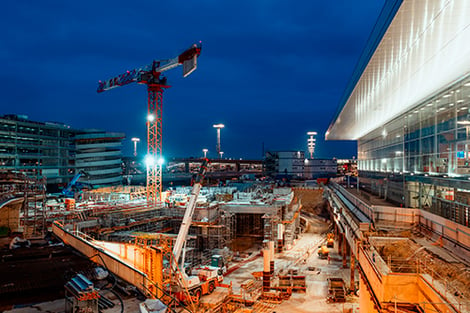 Another challenge of selling government lighting is simply finding the work — you can’t bid on a project if you don’t even know it exists. The good news is that a lot of government information is public. If you keep your ear to the ground, you’ll hear about public developments, bond packages for building improvements, and other government projects.
Another challenge of selling government lighting is simply finding the work — you can’t bid on a project if you don’t even know it exists. The good news is that a lot of government information is public. If you keep your ear to the ground, you’ll hear about public developments, bond packages for building improvements, and other government projects.
It also helps to work with your network. If you partner with municipalities, ask about newly approved public buildings, remodels, and other government projects. You should also ask your partners and vendors about any new construction they’re involved in.
Finally, you might consider subscribing to services like Dodge Construction Central, which provides verified project data to contractors. These types of services can alert you when permits are pulled for government remodels and new construction projects.
Related Reading: Bright Ideas on Installing Dimmable LED Lighting
 Key Questions to Ask a Government Client
Key Questions to Ask a Government Client
"Close enough for government work" doesn’t apply in the lighting industry. You need to have clear and complete information in order to win the bid and prevent problems down the road once the project is underway.
To help you get started, here are a few key questions you’ll want to make sure you get answers to.
Question 1: What’s Being Replaced or Updated?
Why You Should Ask: To quote out a bid on a government project, you need to know exactly what needs to get done. Make sure you ask for as much detail as possible so that you and the client are on the same page.
Question 2: How Many Phases Will This Project Have?
Why You Should Ask: Large government buildings and military bases may require a phased approach to a big lighting project, especially if construction could disrupt operations. Make sure you find out how they want to phase in new lighting so you can plan accordingly.
Question 3: What Is the Timeline?
Why You Should Ask: Government projects aren’t known for their speed. You can save yourself a lot of frustration by establishing the expected timeline up front and taking it into account.
Question 4: What Technology Are You Looking to Invest in?
Why You Should Ask: Beyond LED lighting, government clients looking to save energy and money may be interested in smart technology. For instance, IoT technology offers a suite of networked lighting options that offer great long-term benefits. Be sure to ask if it’s right for your client.
Question 5: What Other Vendors Are Being Considered?
Why You Should Ask: Typically, government projects are put up for bid to multiple parties. It may help your own proposal development if you know who the other players are.
Question 6: Is There an Existing Written Spec, or Do You Need Assistance Writing One?
Why You Should Ask: Written specs help to ensure that the finished project is aligned with what the customer wants. That’s why it’s a good idea to ask to see a copy, or — if one doesn’t exist — to help your customer write it.
Question 7: Who Else Is Involved in This Project? Is There an Architect, General Contractor, Electrical Contractor, Consulting Engineer, etc.?
Why You Should Ask: On government projects, you never know exactly what you’re walking into. If you’re going to be working with other contractors, an architect, engineers, and so on, it’s a good thing to know as early into the project as possible.
Question 8: Who Approves the Final Specifications?
Why You Should Ask: It’s not uncommon on government projects for the decision maker to stay out of the weeds. That can lead to surprises if they’re not on board with the final specifications. Make sure you find out who it is that can grant your plan’s final approval.
Question 9: What Regulations Will Affect This Project?
Why You Should Ask: Government projects have their own special set of hoops you may need to jump through. While your contact may not have all the information you need, it’s a good idea to check in so you can start to get a sense of what you’re in for.
Benefits of Litetronics Products for Government Clients
 For more than half a century, Litetronics has been a leader in the LED lighting industry. We’ve helped clients in federal, state, and local governments, as well as clients in military installations and schools. Our experience makes us the right partner to help you provide high-quality products for your government projects.
For more than half a century, Litetronics has been a leader in the LED lighting industry. We’ve helped clients in federal, state, and local governments, as well as clients in military installations and schools. Our experience makes us the right partner to help you provide high-quality products for your government projects.
Here are just a few of the benefits your customers are going to love:
- The superior energy efficiency provided by LED lighting means your customers will see a great return on investment when they choose Litetronics products.
- For government clients working to meet federal sustainability goals, LED lighting can play an important role in reducing carbon emissions.
- Litetronics products are designed to thrive in even the toughest conditions, making them ideal for outdoor and security lighting.
- All our LED fixtures are backed by a 10-year warranty. For major government projects, that guarantee means you won’t break your budget on making repairs.
- Litetronics products are designed to be easy to install, making them perfect for large-scale government projects.
Why Selling Government Lighting Is a ‘Capitol’ Idea
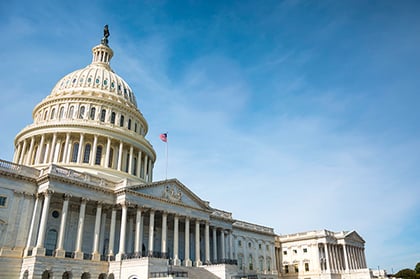 Right now, governments around the world are struggling to catch up to the threat of climate change. While there is no single perfect solution, most of these governing bodies recognize that changes in the way people use and consume energy can have a positive effect on the climate. As a result, our government has issued energy efficiency standards for federal buildings that can be achieved, in part, by LED lighting.
Right now, governments around the world are struggling to catch up to the threat of climate change. While there is no single perfect solution, most of these governing bodies recognize that changes in the way people use and consume energy can have a positive effect on the climate. As a result, our government has issued energy efficiency standards for federal buildings that can be achieved, in part, by LED lighting.
State and local governments are also looking for ways to save energy, motivated in part by environmental concerns but also by their own bottom line. Energy conservation is a smart way to save taxpayer money, and, once again, LED lighting is a great way to do it.
It’s always rare to find a solution that solves for multiple problems at once, but the great thing about LED lighting is that it offers so many benefits. And we haven’t even touched on the fact that LED lights produce less waste and require less maintenance — further reducing their carbon footprints.
The versatility of LED lighting means there’s a huge opportunity for you among government clients. With this guide, we hope you have the tools that you need to win more of these jobs and do some great work. If you’d like to learn more about selling, or about the benefits of Litetronics products, please contact us today.

